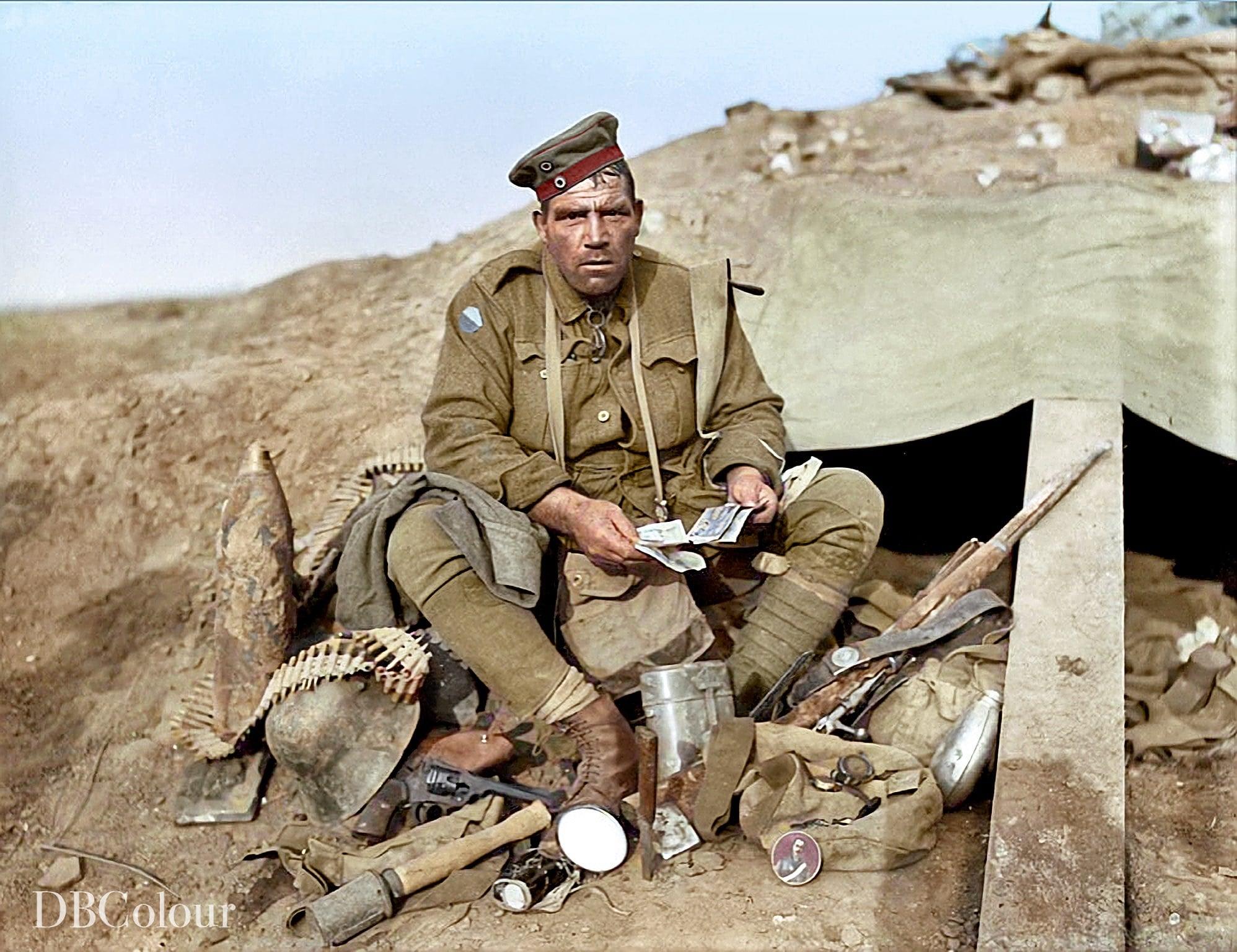Stranger Than Fiction
Colourful – Larger Than Life Character
John (Barney) Hines
The Extraordinary, Apocryphal Tale of Private No. 2296, John “Barney” Hines, Australian Imperial Force, 45th Battalion: Photo: September 27, 1917
The Story
Private John “Barney” Hines, affectionately known as the “Souvenir King,” earned his nickname through an almost legendary habit: collecting mementos from the German dead and even those he captured. Despite his kleptomaniac tendencies and a notorious disregard for military discipline, Hines was widely regarded as one of the bravest men at the front—an attribute that might have earned him numerous decorations under different circumstances.
Hines’s penchant for pilfering everything from medals and badges to rifles, helmets, and watches was well known throughout the trenches. His reputation was further cemented on September 27, 1917, when a photographer captured him surrounded by his loot after the Third Battle of Ypres. The circulated prints eventually reached German soldiers—and from them, the enraged Kaiser.
Born in Liverpool, England, in 1873 to an Irish family, Hines was a natural rebel. At just 14, he ran away to enlist in the army, only to be forcibly returned by his mother. Two years later, he joined the Royal Navy and saw action during the Boxer Rebellion, serving on a gunboat chasing pirates in the China Sea. After his discharge, he embarked on a global quest for gold, which took him to South Africa during the Boer War, where he served as a scout with various British units.
His pursuit of fortune led him across the United States, South America, and New Zealand. While working in a sawmill in Australia, World War I erupted in August 1914. Despite being in his early 40s, Hines persisted in his desire to serve, eventually securing a place in France in 1916 as reinforcement for the 45th Battalion.
Once in France, Hines’s larger-than-life persona truly emerged. Eschewing conventional weaponry such as his .303 rifle, he preferred to charge into battle with two sandbags packed with Mills bombs. His commanding officer later provided him with a Lewis gun—a decision that proved immediately successful. In his characteristic broad Liverpudlian accent, Hines declared, “This thing’ll do me. You can hose the bastards down.”
Known also as “Wild Eyes,” Hines inspired confidence in both officers and men. One commanding officer remarked, “I always felt secure when Wild Eyes was about. He was a tower of strength in the line—I don’t think he knew what fear was.” His exploits, both audacious and unpredictable, included capturing enemy prisoners, orchestrating daring assaults on enemy positions, and amassing a veritable treasure trove of “souvenirs.”
In one particularly memorable incident, frustrated by sniper fire from a German pillbox, Hines charged the structure, leapt onto its roof, and performed a war dance while taunting the enemy. When his provocation failed to elicit a response, he lobbed Mills bombs through the gun port, forcing 63 surviving Germans to emerge with their hands raised. On another occasion, he infiltrated a damaged German dressing station, where a casual tap on a surgeon’s shoulder resulted in instant death from a shell splinter—an episode that underscored both his audacity and his macabre sense of humor.
Hines’s exploits were not confined to small items. At Villers-Bretonneux, he famously “liberated” a piano, which he kept for several days before parting with it. On another occasion, he carried a grandfather clock back to the trenches—until its hourly chimes attracted German fire, prompting his comrades to destroy it with a Mills bomb. In Armentières, after discovering a keg of Bass, he attempted to roll it to his battalion, only to be halted by military police; undeterred, he rallied his fellow soldiers to enjoy the brew on the spot.
The legend of Hines grew even further when, upon reaching Amiens, he encountered the deserted splendor of the Cathedral City. Overwhelmed, he vanished—only to be later discovered in the vaults of the Bank of France, where he had stashed millions of francs in suitcases. After being briefly detained and questioned by British authorities—who ultimately returned him to his unit—Hines boasted that the escapade had cost him no more than 14 days’ pay, and he was permitted to keep the spoils.
Despite his incorrigible nature, Hines was an exceptional soldier. Notably, he once captured 10 German soldiers single-handedly. At Passchendaele, he was the sole survivor of a direct hit on his Lewis gun nest—being blasted approximately 20 feet, with the soles of his boots destroyed—yet he crawled back, restored the gun, and continued firing until he succumbed to leg wounds.
Hines also became renowned for a raucous party at Villers-Bretonneux, after discovering a cache of 1870 champagne and tinned delicacies, complemented by top hats and dress suits he had acquired. Unfortunately, the revelry was short-lived; shortly after, he sustained a bullet wound above his eye, another in his leg, and was exposed to gas. Hospitalized at Etaples and nearly blinded, he later faced a German bombing of the hospital that claimed 3,000 lives. In a remarkable act of resilience, Hines managed to haul himself out of bed, fashioned a broom into a crutch, and spent an entire night ferrying the wounded to safety.
Eventually invalided home, Hines continued to lead a colourful life, working as a drover, shearer, prospector, and timber cutter. Even in his 60s, when his volunteer service for World War II was initially rejected on medical grounds, he attempted to stow away on a troopship—though he was caught before reaching his destination.
After a life filled with adventure, controversy, and indomitable spirit, John “Barney” Hines died penniless at the Concord Repatriation Hospital in Sydney on January 30, 1958, at the age of 84.
This account provides an insightful, albeit apocryphal, glimpse into the life of one of history’s most colourful and unpredictable soldiers—a man whose legend continues to captivate those with a taste for military lore and adventure..

